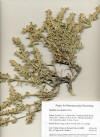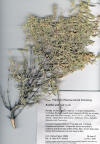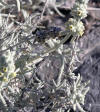|
Buddleja marrubifolia |
Buddleja scordioides |
|
Buddleja utahensis |
Buddleja utahensis
|
|
Buddleja utahensis
|
|
|
Acevedo L., E. Martinez, P. Castaneda, S. Franzblau, B. N. Timmermann, E. Linares, R. Bye and R. Mata. 2000. New phenylethanoids from Buddleja cordata subsp. cordata. Planta Med. 66(3): 257–261. “Bioassay-guided fractionation of a crude extract of the stem bark of Buddleja cordata subsp. cordata with significant antimycobacterial activity led to the isolation of a mixture composed by ten new long-chain esters of 2[4'-hydroxyphenyl]-ethanol (1-10), along with the lichen metabolites methyl beta-orcinolcarboxylate (11) and beta-orcinolcarboxylate (12). Extensive HPLC allowed the separation of the major components of the mixture, which were characterized by spectral means as 2[4'-hydroxyphenyl]-ethyl stearate (3), 2[4'-hydroxyphenyl]-ethyl behenate (6), and 2[4'-hydroxyphenyl]-ethyl lignocerate (8). The minor esters were identified as 2[4'-hydroxyphenyl]-ethyl palmitate (1), 2[4'-hydroxyphenyl]-ethyl heptadecanoate (2), 2[4'-hydroxyphenyl]-ethyl nonadecanoate (4), 2[4'-hydroxyphenyl]-ethyl arachidate (5), 2[4'-hydroxyphenyl]-ethyl tricosanoate (7), 2[4'-hydroxyphenyl]-ethyl pentacosanoate (9), and 2[4'-hydroxyphenyl]-ethyl hexacosanoate (10) by GC-MS analysis of the methyl esters derivatives of the fatty acids obtained by alkaline hydrolysis of the mixture. Compound 8 exhibited moderate antibacterial activity against Mycobacterium tuberculosis (MIC = 64 micrograms/ml).” Avila J. G., J. G. de Liverant, A. Martinez, G. Martinez, J. L. Munoz, A. Arciniegas and A. Romo de Vivar. 1999. Mode of action of Buddleja cordata verbascoside against Staphylococcus aureus. J. Ethnopharmacol. 66(1): 75–78. “We evaluate the mode of action of verbascoside obtained from Buddleja cordata against Staphylococcus aureus by killing kinetics and incorporation of precursors methods. Verbascoside induced lethal effect on S. aureus, by affecting protein synthesis and inhibiting leucine incorporation.” Emam A. M., R. Elias, A. M. Moussa, R. Faure, L. Debrauwer and G. Balansard. 1998. Two flavonoid triglycosides from Buddleja madagascariensis. Phytochemistry 48(4):739–742. “The structures of two new flavonoid triglycosides isolated from leaves of Buddleja madagascariensis have been established as hesperetin and diosmetin 7-O (2",6"- di-O-alpha-L-rhamnopyranosyl)-beta-D-glucopyranosides using mass and NMR spectroscopy. Scutellarien 7-glucoside is reported from this plant for the first time.” Emam A. M., A. M. Moussa, R. Faure, R. Elias and G. Balansard. 1997. Isolation of mimengoside B, a triterpenoid saponin from Buddleja madagascariensis. J. Ethnopharmacol. 58(3): 215–217. “The leaves of Buddleja madagascariensis are traditionally used to treat asthma, coughs and bronchitis. In this report we describe, for the first time, the identification of mimengoside B, a triterpenoid saponin, in the leaves of this plant.” Emam A. M., A. M. Diaz-Lanza, L. Matellano-Fernandez, A. M. Moussa and G. Balansard. 1997. Biological activities of buddlejasaponin isolated from Buddleja madagascariensis and Scrophularia scorodonia. Pharmazie 52(1): 76–77.
Houghton P. J., A.
Y. Mensah, N. Iessa and L. Y.Hong. 2003. Terpenoids in Buddleja:
relevance to chemosystematics, chemical ecology and biological activity. Houghton P. J. and H. Hikino. 1989. Anti-hepatotoxic activity of extracts and constituents of Buddleja species. Planta Med. 55(2): 123–126.
Houghton P. J.
1984. Ethnopharmacology of some Buddleja species. J.
Ethnopharmacol. 11(3): 293–308. Liao Y. H., P. J. Houghton and J. R. Hoult. 1999. Novel and known constituents from Buddleja species and their activity against leukocyte eicosanoid generation. J Nat Prod. 62(9): 1241–1245. “We have undertaken a systematic survey of the genus Buddleja used in traditional Chinese medicine for antiinflammatory and other indications by testing extracts and isolated natural products for their activity against the enzymes of the arachidonate cascade. This was done by using elicited rat peritoneal leukocytes, a physiologically relevant established whole cell system that expresses both cyclo-oxygenase (COX) and 5-lipoxygenase (5-LOX) activity. Lipophilic extracts of B. globosa roots and B. myriantha stem exhibited inhibitory activities in the 5-LOX and COX enzyme assays, whereas those of B. officinalis flowers, B. yunanesis stems, and B. asiatica stems showed inhibitory activities only against COX. The phytochemical investigation of these extracts, and consequent structure elucidation of isolated compounds using spectroscopic data, led to the isolation from B. globosa of three new terpenoid compounds named dihydrobuddledin A, buddledone A, and buddledone B and four known compounds-buddledins A, B, and C and zerumbone; 12 known compounds from B. officinalis-calceolarioside, campneoside, verbascoside, echinacoside, forsythoside B, angoroside A, crocetin monogentibiosyl ester, acacetin, acacetin-7-O-alpha-L-rhamnopyranosyl (1-6)-beta-D-glucopyranoside, acacetin-7-O-alpha-L-rhamnopyranosyl (1-6)[alpha-L-rhamnopyranosyl (1-2)]-beta-D-glucopyranoside, songarosaponin A, delta-amyrone; and eight known compounds fromB. yunanesis-11,14-dihydroxy-8,11, 13-abietatrien-7-one, beta-sitosterol, verbascoside, echinacoside, forsythoside B, angoroside A, methylcatapol, and sucrose. Tests on the isolated compounds for inhibition of eicosanoid synthesis showed that buddledin A, crocetin monogentibiosyl ester, and acacetin exhibited an inhibitory effect on COX with IC(50) values of 13.7 microM, 28.2 microM, and 77.5 microM, respectively, whereas buddledin A exhibited inhibitory effect on 5-LOX with an IC(50) value of 50.4 microM.”
Matsuda H., H.
Cai, M. Kubo, H. Tosa and M. Iinuma. 1995. Study on anti-cataract
drugs from natural sources. II. Effects of buddlejae flos on in vitro
aldose reductase activity. Mensah A. Y., P. J. Houghton, S. Bloomfield, A. Vlietinck, D. Vanden Berghe. 2000. Known and novel terpenes from Buddleja globosa displaying selective antifungal activity against dermatophytes. J. Nat. Prod. 63(9): 1210–1213. “Lipophilic extracts of the stembark of Buddleja globosa were found to have antifungal activity at 125 microg/mL against three dermatophytic fungal species but had no activity at 1000 microg/mL against four other fungal species or two yeast species. Bioassay-guided fractionation of Si gel column eluates using the sensitive fungal species resulted in active fractions from which were isolated five compounds that were characterized by spectroscopic methods as one novel and four known compounds. The known compounds were the diterpene buddlejone (1), the bisditerpene maytenone, and the two sesquiterpenes buddledin A and buddledin B, while the novel compound was characterized as the diterpene deoxybuddlejone (2). The minimum inhibitory concentration of all the compounds was determined against all the microorganisms under test, and buddledins A and B were shown to exhibit the greatest antifungal activity, with values of 43 microM and 51 microM, respectively, against the sensitive fungi Trichophyton rubrum, Tricophyton interdigitale, and Epidermophyton floccosum.” Pardo F, F. Perich, L. Villarroel and R. Torres. 1993. Isolation of verbascoside, an antimicrobial constituent of Buddleja globosa leaves. J. Ethnopharmacol. 39(3): 221–222. Yamamoto A., S. Nitta, T. Miyase, A. Ueno and L. J. Wu. 1993. Phenylethanoid and lignan-iridoid complex glycosides from roots of Buddleja davidii. Phytochemistry 32(2): 421–425. |
|







